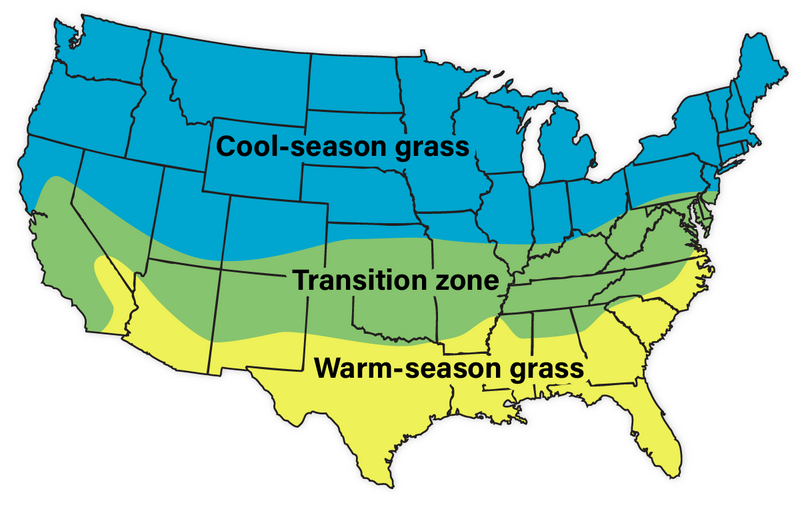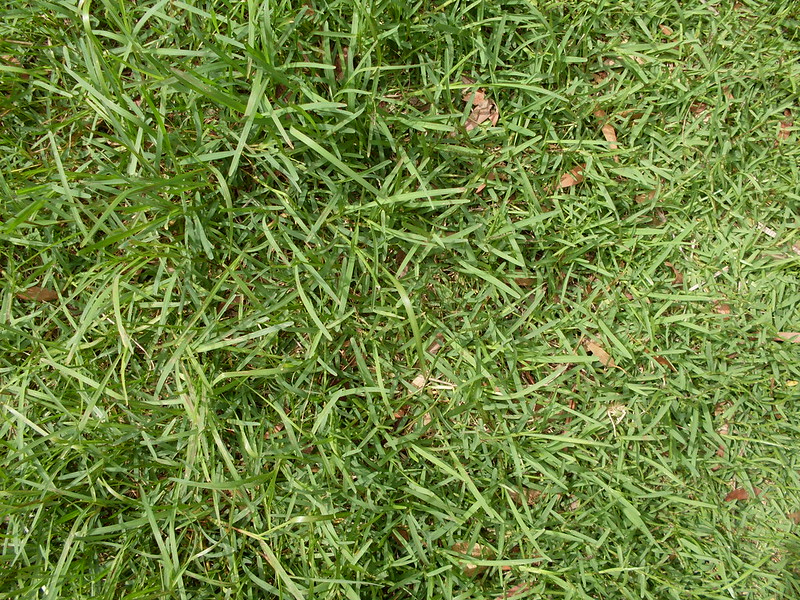
You love our xeriscape, but a patch of grass between your toes wouldn’t hurt. Which grasses will succeed in your Little London lawn? We’ve got the scoop on the 6 best grass types for Colorado Springs.
Cool-season grasses:
Warm-season grasses
Cool-season grasses for Colorado Springs
Most of Colorado is in the cool-season zone. The state faces cold weather throughout most of the year, which is perfect for cool-season grass.
Cool-season grasses prefer the low temperatures of spring and autumn. They’ll enter dormancy when the hot weather strikes in summer and winter turns ice cold.

Brenda Ryan | Lawn Love
1. Kentucky bluegrass
Kentucky bluegrass is a Colorado favorite. Ask your neighbor what grass they’re growing, and they’ll probably say Kentucky bluegrass or KBG.
A Kentucky bluegrass lawn is dense, resilient, and blue-green. Once established, it spreads readily via underground rhizomes and heals quickly after heavy foot traffic. The grass offers excellent cold hardiness and can recover rapidly after prolonged drought or extreme heat.
The one downside: KBG has low drought tolerance. Drought is common here in The Centennial State, which doesn’t pair well with this thirsty grass. KBG needs plenty of water to remain green and beautiful, which can be stressful on the local water supply.
- Classification: Cool-season
- Spreads by: Rhizomes
- Shade tolerance: Moderate
- Drought tolerance: Low
- Foot traffic tolerance: High
- Maintenance needs: Moderate
- Recommended mowing height: 2 ½-3 inches
Grass Seed Options:
– Jonathan Green (11970) Blue Panther Kentucky Bluegrass Grass Seed (3 lbs.)
– SeedRanch Midnight Kentucky Bluegrass Seed (5 lbs.)
– Jacklin Seed – Biltmore Blue Blend – 100% Kentucky Bluegrass (5 lbs.)

Ty Haller | Flickr | CC BY-SA 2.0
2. Tall fescue
Tall fescue grass is an excellent drought-resistant alternative to KBG. It develops deep roots in well-drained soils, which means it can access moisture far better than KBG. You won’t have to water your tall fescue lawn as much as a KBG lawn.
Tall fescue is also more tolerant of shade and salty soils than KBG. So if you have a tall tree that tends to shade out parts of the yard, tall fescue may be the way to go. The grass has few disease and insect problems and requires less fertilizer than KBG. Thatch is also less of a problem with tall fescue.
On the flip side, tall fescue grows fast, which means you may spend a lot of time pushing the mower and sharpening your mower blades.
The grass also boasts a high heat tolerance compared to most cool-season grasses.
- Classification: Cool-season
- Spreads by: Grows in clumps and spreads via tillers
- Shade tolerance: High
- Drought tolerance: High
- Foot traffic tolerance: High
- Maintenance needs: Low
- Recommended mowing height: 2-3 inches
Grass Seed Options:
– Triple-Play Tall Fescue Grass Seed Blend (5000 sq ft)
– Eretz Kentucky 31 K31 Tall Fescue Grass Seed (choose your size)
– Pennington The Rebels Tall Fescue Grass Seed Mix (7 lb.)

Matt Lavin | Flickr | CC BY-SA 2.0
3. Fine fescue
A fine fescue lawn’s characteristics will vary depending on the species. Fine fescue species include chewings fescue, hard fescue, sheep fescue, and creeping red fescue.
Fine fescue grasses are generally drought-tolerant. They tolerate poor soil conditions, including rocky, sandy, and clay soils. They have a moderate to very good salt tolerance and high shade tolerance.
This grass may not be ideal if you enjoy family badminton tournaments in the backyard. It has a low foot traffic tolerance, which means outdoor games might do a number on it.
- Classification: Cool-season
- Spreads by: Chewings fescue, hard fescue, and sheep fescue are all bunch-type grasses. Creeping red fescue is the only fine fescue species that spreads by rhizomes.
- Shade tolerance: High
- Drought tolerance: High
- Foot traffic tolerance: Low
- Maintenance needs: Low
- Recommended mowing height: 2 ½ -3 inches
Grass Seed Options:
– Outsidepride Legacy Fine Fescue Grass Seed (5 lbs.)
– Eretz Creeping Red Fine Fescue Seed (choose your size)
– Outsidepride Creeping Red Fine Fescue Grass Seed (25 lbs.)
– Outsidepride Hard Fine Fescue Grass Seed (10 lbs.)

iStock
4. Perennial ryegrass
If you decide to opt for one of Colorado’s warm-season grasses, expect your lawn to turn tannish-brown as temperatures drop. Yet you can lengthen its green period by overseeding with cool-season perennial ryegrass.
Perennial ryegrass is a fast-growing, temporary ground cover that will bring a flush of green to your cold autumn lawn. As warm spring temperatures return, the perennial ryegrass will fade as your warm-season grass exits dormancy and takes over.
- Classification: Cool-season
- Spreads by: Is a bunchgrass that produces tillers
- Shade tolerance: Low
- Drought tolerance: Moderate
- Foot traffic tolerance: High
- Maintenance needs: Low
- Recommended mowing height: 2.5-3 inches
Grass Seed Options:
– Outsidepride Perennial Ryegrass Seed (5 lbs.)
– Eretz ProTurf Perennial Ryegrass Fine Lawn Seed (choose your size)
Warm-season grasses for Colorado Springs

Northern states are in the cool-season zone because they experience long, frigid winters and mild summers. Southern states are in the warm-season zone because of their long, boiling summers and mild winters.
But what about the states in the middle? These states are in the transition zone, and they tend to have boiling summers and icy winters. Both cool-season and warm-season grasses can grow in this zone.
Much of Colorado is in the cool-season zone, but Colorado Springs lies on the cusp of the transition zone. That means temperatures are warm enough throughout the year to warrant a warm-season grass with high cold tolerance.

John Tann | Flickr | CC BY-SA 2.0
1. Buffalograss
Buffalograss is native to Colorado and much of the North American Great Plains. Newer varieties offer a dark green, dense, short-growing turf.
Its growing period is from late May through early September. It enters dormancy during fall’s first hard frost and exits dormancy mid-to-late spring. Its long dormancy and short growing season may deter some homeowners, but you can lengthen your lawn’s green period by overseeding with cool-season perennial ryegrass in fall.
Homeowners who plant newer buffalograss varieties may find their lawn survives on 50% to 75% less irrigation than Kentucky bluegrass, requires less frequent mowing, and only needs one to two fertilizer applications a year.
Keep in mind that buffalograss does not grow well in elevations above 6,500 feet.
- Classification: Warm-season
- Spreads by: Stolons
- Shade tolerance: Low
- Drought tolerance: High
- Foot traffic tolerance: Low
- Maintenance needs: Low
- Recommended mowing height: 1.5-3 inches
Grass Seed Options:
– Everwilde Farms Buffalograss Seeds (1 lb. of seeds)
– Buffalograss seed (primed) (5-lb. bag)
2. Blue grama
Blue grama is another warm-season Colorado native. If you’re looking for grass that will blend into your xeriscape, blue grama is an excellent choice. It can remain green for weeks without water, and Colorado Springs Utilities even recommends it as a water-wise plant.
Let the grass grow tall, and its bluish-green seed heads will fit right in with your wildflower meadow or naturalized landscape areas. Otherwise, mowing the grass will give you a light green lawn.
- Classification: Warm-season
- Spreads by: Rhizomes
- Shade tolerance: Low
- Drought tolerance: High
- Foot traffic tolerance: Good, except when it goes dormant from May to October
- Maintenance needs: Low
- Recommended mowing height: 1.5-2 inches
Grass Seed Options:
– Everwilde Farms Blue Grama Grass Seeds (1 lb.)
– Nature’s Seed Blue Grama Grass Seeds (1 lb.)
Choosing the right grass for your Colorado Springs lawn
Six types of grass will grow well in your Colorado Springs lawn, but which one is the right fit? A helpful way to narrow down your choice is to consider what characteristics you need in a yard.
- Do you need a grass type that grows well in the shade?
- Tall fescue and fine fescue grow well in the shade.
- Do you need a grass type for your drought-resistant landscape?
- Tall fescue, fine fescue, buffalograss, and blue grama have high drought tolerance.
- Will you be walking on or using your lawn frequently?
- Kentucky bluegrass, tall fescue, and perennial ryegrass have high foot traffic tolerance.
- Do you prefer grass that’s low maintenance?
- Tall fescue, fine fescue, perennial ryegrass, buffalograss, and blue gramma are all low-maintenance grasses.
- What time of year do you want to enjoy your lawn?
- Warm-season grasses actively grow in summer and cool-season grasses actively grow spring and fall.
Is an overgrown lawn keeping you from enjoying your favorite city? Don’t miss a day at Cheyenne Mountain Zoo because the grass needs mowing. Hire a local lawn care professional who can handle the lawn chores for you.
Main Photo Credit: David Shankbone | Wikimedia Commons | CC BY-SA 3.0
Lawn Love participates in the Amazon Services LLC Associates Program, an affiliate advertising program. Lawn Love may earn revenue from products promoted in this article.